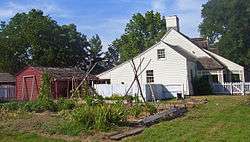John Neville (general)
John Neville (July 26, 1731 – July 29, 1803) was an American military officer, land speculator, and state official who served in the French and Indian War, American Revolutionary War and, as a tax collector, was a central figure in the Whiskey Rebellion. He was the father of Presley Neville.

Personal and public life
Neville's parents were Joseph Neville Sr. (son of John Neville and Elizabeth Bohannan) and Ann Bohannan (Joseph married his cousin). Joseph had a brother George who married Hannah Burroughs, a cousin of Lord Fairfax of Cameron. Legend holds that George himself was an emigrant, kidnapped from England as a boy and brought to Virginia,[1] however this has been disputed by his descendants and is not supported by historical documents.[2]
John Neville was born in Virginia on his father's estate near the head of Bull Run (Occoquan River).[3] In 1754, Neville married Winifred Oldham,[4] also of a prominent Virginian family.[5] Outside of his military service, he was sought-after for government appointments. He was sheriff in Frederick County, Virginia, and although he was appointed the Augusta County delegate to the Virginia Conventions, illness prevented his participation. In 1776, he was offered a commission as a Yohogania County justice, but he declined and continued his work as a soldier in Pennsylvania. In 1783, Neville was elected to the Supreme Executive Council of Pennsylvania from Washington County.[3] As a result of his family connections over the course of his life, Neville was "as close to being an aristocrat as republican America west of the Alleghenies would allow."[5]
Military service
Neville served with British General Edward Braddock during the French and Indian War, and fought in Dunmore's War in 1774. Commandant at Fort Pitt when the Revolutionary War began, Neville served in several regiments of the Virginia Line, rising to the rank of colonel and seeing action at Trenton, Princeton, Germantown, and Monmouth. At the end of the Revolutionary War he was awarded a brevet promotion to brigadier general.
After the war, Neville was an inspector of revenue under the excise laws, which the newly formed United States Congress imposed on distilled spirits to help pay for the cost of the Revolutionary War. There were two methods of paying the whiskey excise: paying a flat charge or paying by the gallon. The tax effectively favored large distillers, most of whom were based in the east, who produced whiskey in volume and could afford the flat fee. Western farmers who owned small stills did not usually operate them at full capacity, so they ended up paying a higher tax per gallon. Thus, large producers ended up paying a tax of about 6 cents per gallon, while small producers were taxed at about 9 cents per gallon.[6]
Events climaxed in 1794, according to Alexander Hamilton, when shots were fired at Neville and a U.S. Marshal he was escorting through the area to summon to court farmers who had not paid the tax. On July 16, 1794, a group of around fifty men surrounded the Neville mansion, demanding to see the US Marshal. The confrontation led to Neville's shooting of one of the protesters. Neville and his slaves were not injured during the fight. This further angered the people, and the next day, over 500 again surrounded the home. At least one more protester died, and Neville's home, Bower Hill, was burned to the ground, including the slave quarters.[7]
This incident persuaded President George Washington to take the drastic action of leading a militia force of 13,000 men into western Pennsylvania to squelch the uprising. This response marked the first time under the new Constitution that the federal government had used a strong military presence to exert authority over the nation's citizens. In 1802, the tax was repealed.
Legacy
He is buried in Pittsburgh's Allegheny Cemetery.
Neville built two mansion-style homes near Pittsburgh. The first, "Bower Hill", was burned in 1794 during the Whiskey Rebellion, and the second, "Woodville", survives today; owned by the Pittsburgh History and Landmarks Foundation, it is a National Historic Landmark.
Neville Island, Pennsylvania, is named after Gen. John Neville.[8]
References
- Baldwin, Leland D. (1968). Whiskey rebels: the story of a frontier uprising. Pittsburgh: University of Pittsburgh Press. pp. 44–48.
- Bruch, Virginia (1988). Proud Wanderers. pp. 224–9.
- Fleming, George T. (1922). History of Pittsburgh and environs: from prehistoric days to the beginning of the American revolution, Vol. 5. Pittsburgh: University of Pittsburgh Digital Research Library. p. 117.
- Episcopal Church, Diocese of Pittsburgh Historical Society (1912). The Neville Memorial: services and addresses ; November 2d, 1912, St. Luke's Church, Woodville, Pa. Pittsburgh: University of Pittsburgh Digital Research Library. pp. 6–7.
- Rishel, Joseph Francis (1990). Founding families of Pittsburgh: the evolution of a regional elite, 1760-1910. Pittsburgh: University of Pittsburgh Press. pp. 32–37.
- "The Whiskey Rebellion". Friendship Hill National Historic Site. U.S. National Park Service. Retrieved 23 October 2013.
- Slaughter, Thomas P. (1986). The Whiskey Rebellion: Frontier Epilogue to the American Revolution. New York: Oxford University Press. p. 3. ISBN 0195051912.
- Stotz, Charles Morse (1966). The architectural heritage of early western Pennsylvania: a record of building before 1860. Pittsburgh: University of Pittsburgh Press. p. 34.
External links
| Preceded by Dorsey Pentecost |
Member, Supreme Executive Council of Pennsylvania, representing Washington County November 11, 1783 – November 20, 1786 |
Succeeded by David Redick |